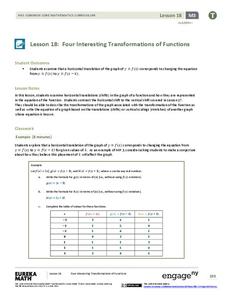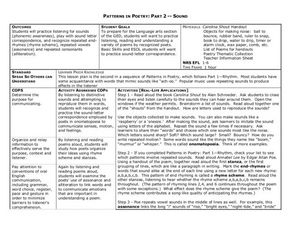EngageNY
Applications of Congruence in Terms of Rigid Motions
Corresponding parts, congruent parts, congruent corresponding parts—what does it all mean? The resource challenges pupils to identify corresponding parts for pairs of figures. It uses examples of figures that undergo rigid...
Florida Center for Reading Research
Phonics: Letter-Sound Correspondence, Medial Phoneme Spin
A collaborative activity challenges young scholars to match medial graphemes and phonemes. Pairs take turns spinning the spinner, naming the letter, and saying its name. They choose from a stack of cards with the same medial sound.
Curated OER
Corresponding Parts of Similar Triangles
Here is a lesson that has learners take a look at corresponding parts of similar triangles, ratios of similarity, reductions and enlargements. They'll manipulate the scale factor (r) to observe the changes in similar triangles and then...
Curated OER
Corresponding Parts of Congruent Triangles
Students identify different parts of a triangle. In this geometry lesson, students differentiate between similar and congruent triangles. They use the navigator to crate a visual of the different parts of a triangle.
Curated OER
Guided Reading: Flora's Box
Young readers consider text-to-self connections. Learners discover the text-to-self connection as they read Flora's Box by Tina Althaide. They practice high frequency words, prepositions, and 1:1 correspondence.
Virginia Department of Education
Similar Figures
How similar do figures have to be to be similar figures? Individuals learn to identify similar figures by verifying that angles are congruent and sides are proportional. Additionally, they match the corresponding parts of similar figures.
Curated OER
How Many?
Establish 1:1 correspondence by counting students, first one gender, then the other. Give each child a colored cube (one color for boys, another for girls) and have small groups determine more or less and how many all together. As a...
Curated OER
Mad-Libbing Your Way Into Modern Poetry
Use a Mad-Libs like activity to create modern poetry! Writers will identify different words and their parts of speech and study "The Red Wheelbarrow" by Williams Carlos Williams. Then, use the sheets attached to craft your own poem! An...
EngageNY
Four Interesting Transformations of Functions (Part 2)
What happens to a function whose graph is translated horizontally? Groups find out as they investigate the effects of addition and subtraction within a function. This nineteenth activity in a 26-part series focuses on horizontal...
EngageNY
Four Interesting Transformations of Functions (Part 3)
Continue the study of transformations with an examination of horizontal stretches, shrinks, and reflections. Individuals use the same process used in parts one and two of this series to examine horizontal changes. The resource also...
Curated OER
Phoneme Segmenting Accuracy
Take your kindergartners on a journey to the mythical planet Paz where residents segment words into phonemes, touching parts of their arm with each sound. This physical response to phoneme segmenting will appeal to your physical learners...
Curated OER
Becoming Part of the Community
Students identify how various cultures are similiar. As a class, they read an essay of a Peace Corps volunteer being integrated into their new community. In groups, they take the elements from the story and put them into different...
EngageNY
Representing, Naming, and Evaluating Functions (Part 2)
Notation in mathematics can be intimidating. Use this activity to expose pupils to the various ways of representing a function and the accompanying notation. The material also addresses the importance of including a domain if necessary....
Curated OER
Pondering the Parts of Speech
Fifth graders explore the parts of speech. In this grammar instructional activity, 5th graders categorize words and create sentences using a word from each part of speech. Students locate examples of each part of speech from various...
Book Units Teacher
Skill Lessons – Prefixes and Suffixes
Sometimes the best way to understand a concept is to break it down. Young vocabulary pupils work with word parts in a hands-on activity that prompts them to connect flash cards with affixes to their root and base words. Additionally,...
Curated OER
The Counting Caterpillar
A daily counting routine builds a caterpillar with 100 body segments (marked with symbols to indicate 2s, 5s, and 10s) by the 100th day of school. Provides structured repetition as part of the morning routine so that by 100th day,...
Curated OER
Etymology
Learners dissect and build words from parts like prefixes, base words, suffixes, and inflectional endings. Etymology skills help us find the meanings of words by identifying the different parts that constitute them. Class members use...
Curated OER
Expressive Body Part Identification
Students participate in activities with Mr. Potato Head and Inspector Gadget. During the activity, they must request the body part they want to add to the body. They must state their request in a complete sentence and point to the body...
Curated OER
The Ants Go Marching
Integrate art, math, life science, music, and fun in this beginning addition and subtraction activity. Children kinesthetically represent adding and subtracting numbers to 10; they stand up one at a time as you count forward and sit down...
Heritage Foundation
The Office of the Executive
An executive is not just a leader of a company; you can also use the term to describe the president of the United States. The ninth part of a 20-part unit teaches high schoolers about the importance of the executive branch and the...
Curated OER
Patterns in Poetry: Part 2 -- Sound
Young scholars understand a variety of poems listening for sound letter correspondence, rhyme scheme, assonance, and alliteration. In this language arts lesson, students practice listening and reading skills to complete patterns in...
Curated OER
Cutting Corners - Parts 1 and 2
Learners use optimization concepts to design their own container. In this optimization lesson plan, students understand how the optimization concept is critical in calculus and why products are packaged the way they are.
August House
Billy Brown and the Belly Button Beastie
How would you feel if you lost your belly button? Read about Billy Brown in Billy Brown and the Belly Button Beastie by Bobby and Sherry Norfolk. Young learners retell the story, answer questions, focus on the letter B and parts of the...
Curated OER
Scrutinizing Stand-Ins: Working With Nouns and Pronouns
Use the Schoolhouse Rock episode, "Rufus Xavier Sarsaparilla," to introduce a study of pronouns. Learners consider antecedents, cases (nominative, objective and possessive), as well as types of pronouns, and then craft sentences using...

























